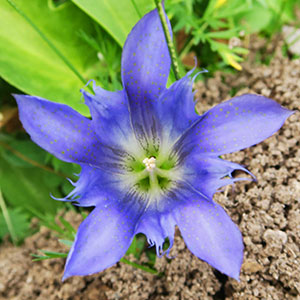Gentiana flavida
Gentiana newberryi
white prairie or white or cream or yellowish or pale gentian
alpine gentian, Newberry's gentian
1–10, terminal from caudex, decumbent to erect.
1–5, arising laterally below rosettes, from a stout tap root, tufted, decumbent.
cauline, ± evenly spaced;
blade lanceolate to ovate, 5–15 cm × 15–50 mm, apex acuminate.
basal and cauline;
blades of basal rosette and proximal cauline leaf blades widely spatulate to obovate or oblanceolate, 0.8–5 cm × 2–25 mm, apex obtuse or mucronate, at least these leaves with blades less than 6 times as long as wide, distal cauline leaves few, with blades oblanceolate to lanceolate or linear, 2–5 cm × 2–5 mm, apices acute.
dense 1–20-flowered cymes, often also with additional clusters at 1 or 2 nodes.
terminal, flowers usually solitary, occasionally 2 or 3.
calyx 10–30 mm, lobes spreading, with bracketlike keels, lanceolate to ovate-triangular, 3–15 mm, margins not ciliate;
corolla white, sometimes with yellowish or greenish tinge (drying yellowish), with veins outlined in green, tubular, loosely closed or slightly open, 30–55 mm, lobes incurved to nearly erect, widely ovate-triangular, 4–6 mm, free portions of plicae obliquely triangular, erose to shallowly lacerate, with minute, deflexed second segment;
anthers connate or some sooner or later distinct.
calyx 14–30 mm, lobes linear to narrowly ovate, (4–)6–12 mm, margins not ciliate;
corolla white or blue, campanulate, open, 23–55 mm, lobes spreading, elliptic-obovate, 7–17 mm, free portions of plicae divided into 2 triangular, serrate to lacerate segments;
anthers distinct.
winged.
winged.
= 26.
Gentiana flavida
Gentiana newberryi
The name Gentiana alba Muhlenberg has often been applied to this species. Uncertainty had long persisted, first as to whether the name G. alba was validly published by G. H. E. Muhlenberg in 1813, then, after that publication had been deemed invalid, whether it was validated by T. Nuttall in 1818. A group of nomenclatural authorities considered this issue on behalf of this flora and concluded that neither of those publications of the name G. alba had been valid, and that G. flavida A. Gray was the earliest validly published name for this species (K. N. Gandhi, pers. comm.).
Outlying eastern populations of Gentiana flavida in North Carolina, Pennsylvania, and West Virginia are no longer extant, and the continued existence of other peripheral populations in isolated prairie remnants is precarious. Reports from Manitoba have been based on misidentified G. rubricaulis. A report from Maryland was based on the misreading of a label of a specimen actually from Indiana (studies for this flora).
In contrast to those of the other species of Gentiana in the flora area, with the exceptions of G. clausa and G. latidens, the calyx lobes of G. flavida spread widely, with keels like shelf brackets decurrent on the tube.
Morphological variation in Gentiana flavida should be given further study. According to J. T. Curtis (1959), plants of this species from the northern part of its range, as seen in the field, appear distinctly different in inflorescence form from plants native farther south.
In the tall-grass prairies, Gentiana flavida hybridizes with G. andrewsii, producing G. × pallidocyanea J. S. Pringle, and G. puberulenta, producing G. × curtisii J. S. Pringle. Reports of G. flavida with the corollas distally lilac have been based on plants derived from such hybridization, probably through backcrossing.
(Discussion copyrighted by Flora of North America; reprinted with permission.)
Varieties 2 (2 in the flora).
The two varieties of Gentiana newberryi intergrade extensively. The most distinctive form of var. newberryi, with relatively tall stems and medium to deep blue corollas, occurs in the northern part of the range of the species, from the Klamath and White mountains of California north into Oregon. Plants most clearly referable to var. tiogana prevail in the southern part of the range of the species, from Butte County south to Inyo and Tulare counties, California. In the central part of the range of the species, plant size and corolla color are less consistently correlated, with occasional plants combining low stature with deep blue corollas or tall stems with predominantly white or pale blue corollas. In that part of the range, corolla color may be highly variable within a single population.
The leaves of Gentiana newberryi are thick-textured and distinctively concave, usually spoon-shaped, when fresh. Narrower leaves sometimes occur in var. tiogana, but many plants of that variety have widely spatulate leaves like those of var. newberryi.
(Discussion copyrighted by Flora of North America; reprinted with permission.)
1. Corollas medium to deep blue with greenish to dark purple lines abaxially on and below lobes, usually 35–55 mm. | var. newberryi |
1. Corollas white to pale blue except for greenish to dark purple lines abaxially on and below lobes, usually 23–42 mm. | var. tiogana |


